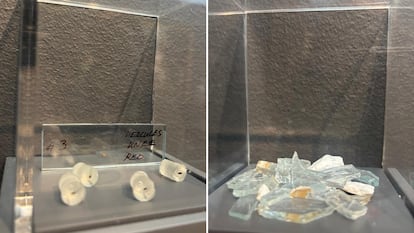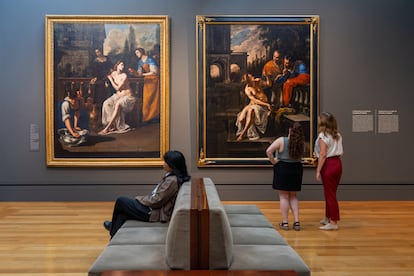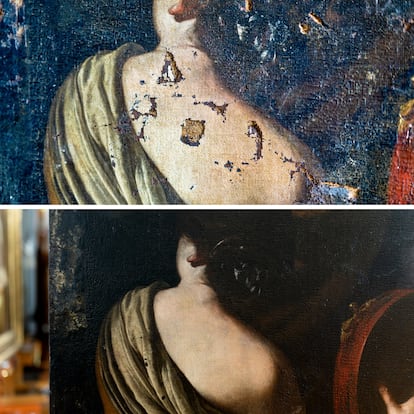In this story, it is difficult to start at the beginning. Because the principle can be, perhaps, the end of the 16th century, with the arrival to the world of artist Artemisia Gentileschi, daughter of Pintor Francesco Gentileschi, friend of kings and prayers, one of the few women recognized in the world of world painting. But the principle can also be the end: the exhibition since June 10 of one of its main works, Hercules and Onfaliaat the Getty Museum in Los Angeles, in California, far from his native Italy, but even more from the place to which this piece belongs now, Beirut.
Because probably there is the origin of this story. In Beirut, that Mediterranean city so many times mistreated and razed, the last one in 2020. Five years ago, on the afternoon of Tuesday, August 4, an immense explosion, caused by almost 3,000 tons of ammonium nitrate, swept everything in its path. As the Sursock Palace, a particular residence with a century and a half of history after whose walls important works of art were kept. Among them, it was Hercules and Onfalia, In a poor state of conservation after decades at residence, where I was not exposed to the public. The explosion left it more than touched: tears, disappeared canvas pieces, dirt and dust. So much so that their owners took a step forward: they needed help. And that is where the remote California enters.
An article in a guild magazine, Apollohe put Ulrich Birkmaier, German, Getty conservation manager, already Davide Gasparotto, Italian, responsible for painting from the center. The first was in charge of traveling to Beirut to see the picture. He was impressed because the damage was important. Then, the institution, with almost 30 years of history, reached an agreement with the family: they would take it to California the necessary time to restore it, they would expose it and then return it to the family in the best possible conditions. Now they have just completed the first two parts of the covenant: the work has been restored almost miraculously. It can be seen in Getty until mid -September; Then, 3,700 kilometers will travel to Ohio, to be exhibited at the Columbus Museum of Art. This institution has lent another artemisia For the exhibition of Los Angeles and, in return, the two can be exposed. Finally, as Birkmaier promised to his legitimate owners, the piece will return to Beirut in 2027. And there, it can finally be seen in public.
Very few people had seen the picture before their restoration. In fact, it was not until 1992 when it was attributed to Artemisia Gentileschi. The Sursock have a museum with their name, but this work was in their private palace. So Gasparotto decided to write to the owners. “And they were very excited,” says Birkmaier and Gasparotto. “They were already preparing the paint to send it to a restoration treatment in Italy, but when we told them we were willing to restore it for free …”. One moment: free? “Yes, yes,” says Birkmaier. “We have a wonderful group, the painting council, art enthusiasts that support conservation treatment, and that provide money for projects like this,” he says.
The nonageny owner of the palace, Lady Cochrane, survived the explosion of 2020, but died a few weeks later. It was always clear that this work was a Gentileschi. When Birkmaier saw her, he didn’t have doubts either. “You could appreciate in the quality of the painting, the style, the brands … that it was a artemisia”, He comments, still amazed by the work. “We had only seen it in photos, and that was when I saw my colleague Davide (Gasparotto) when I suggested contacting the family to see if they needed assistance in treatment and conservation.” Gasparotto did not hesitate either. “There are clear reasons: the way in which the sleeves, the neck, the lace …”, is pointing out. “I think that if you compare with other Naples paintings of mid -1630, there is no doubt that it is,” he says; In fact, it is clear that it is purely of Gentileschi, and not a collaboration of his workshop. In addition, he has reviewed documents from 1699 of a Neapolitan collection in which there is talk of a work of the same topic: “I would say sure that they referred to it.”
That was once the worst part of the pandemic ended. After examining it in Beirut, recalls Birkmaier that was “in very bad conditions.” Already in 2022, the painting flew to Getty. They recognize that it was easy to manage the permits and bring it, carefully and by plane, from Beirut to Frankfurt, from Frankfurt to Los Angeles, in a 747, in a couple of days. There they began to remove an upper layer of paint, supposedly protective, and found huge damage, although they also confirmed, in case there was any doubt, that it was effectively the work of Gentileschi.
The damage was immense, with terrible tears, especially in the knees of Hercules, in an intermediate zone of the painting and in the arms and the skirt of Onfalia. This is shown by a large playback of the original, in the same room where the already restored. The process can also be seen in a video in the room.
“It was difficult because of the size of the work and the extension of the damage. It was even worse, because there were other restorations on top,” says the conservative, which also points out the crystals that were nailed in the painting, today exposed in a showcase. In addition to being very darkened by the dirt of the centuries, it was reinforced with a second canvas, stuck to each other, and also at least a couple of old restorations that had damaged it. In fact, in some areas it had to be practically a reconstruction: “There were many painting losses, but not the explosion. Next to the lower edge, for example; the entire foot is repainted. The fingers had been lost, basically.”

Care has been maximum. The canvas has gone through X -rays and what they call “cross sections” have been done, that is, tiny parts of the painting have been extracted, just millimeter motorcycles, to observe with microscope the material of which it is made.
During the last three years, Birkmaier has spent most of his hours with him, working and non -working. So it was until the last day before exposing yourself in public, and does not promise that it is the last time. The German jokes with which his wife and children came to be certain jealousy to the work: “It is one of the conservations in which I have felt most privileged,” he smiles. “You build a special relationship with the artist when you work in her paintings, and I love Artemisia’s work,” he acknowledges.
Gentileschi, as Gasparotto explains, rubbed shoulders with the most pomegranate of the Neapolitan, Spanish and British Courts, with the Medici, with the Holy See. He believes that he must meet Velázquez, and who painted a picture for Felipe IV that burned in the Alcázar. He did not have an easy life: he was raped in his youth; She was married, but she had her daughter alone; He went through financial difficulties. “It was exceptional. He was alone, on his own, completely,” reflects the Italian.
Now, great cultural institutions such as the Museum of Rome, the National Gallery of London or the Museum of the Prado of Madrid recover it. In Getty, in addition to this Hercules and Onfalia more days of his hangs: a Lucreciaowned by the museum; Susana and the oldof a private collection (restored by the National Gallery of London); Betsabé and Davidof the Columbus Art Museum (Ohio); and a small self -portrait of the author, also from a private collection.

The exhibition will pass to Ohio next spring and from there the picture will return home: Beirut. “It’s a beautiful, incredible city. I have been twice since 2022, and I think their people have to enjoy, they have the right to it,” Birkmaier argues. “They have to be able to rise again, attract tourism again.” In the end, as they recognize, everyone wins: both the privileged hands that have been able to do a complex and long work, and Beirut, for exposing it to the public for the first time; as well as the spectators who can enjoy it in several parts of the world.

